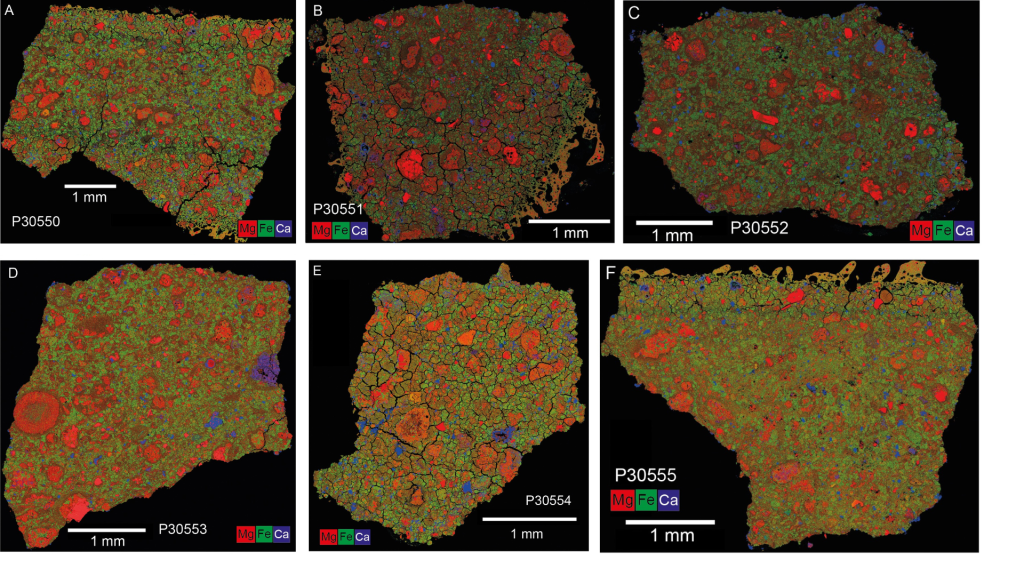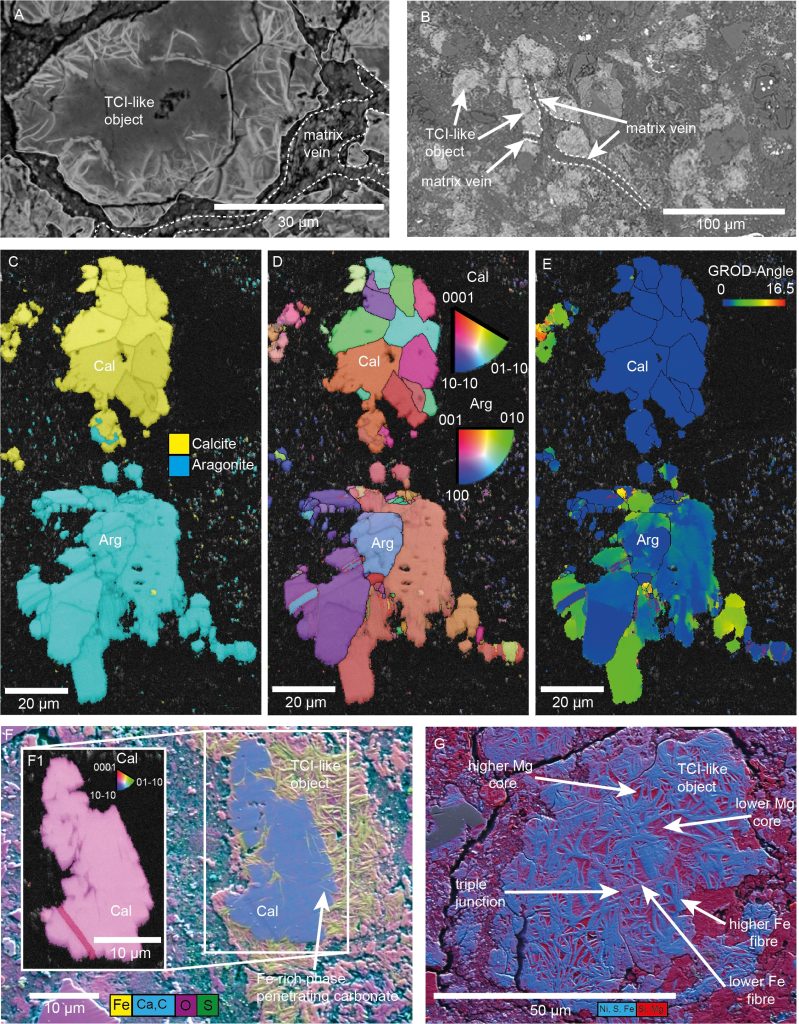New analysis reveals the brutal history of the Winchcombe meteorite’s journey through space

Intensive new nano-analysis of the Winchcombe meteorite by a team including University of Leicester scientists has revealed how it was affected by water and repeatedly smashed apart and reassembled on the journey it took through space before landing in an English sheep field in 2021.
Researchers from dozens of institutions in the UK, Europe, Australia, and the USA collaborated on the research. Together, they subjected mineral grains in fragments of the Winchcombe meteorite to a diverse range of cutting-edge analytical techniques.
Their work, which was conducted on a scale more typically reserved for investigating samples returned to Earth by multibillion-dollar space missions, has given them unparalleled insight into the history of the Winchcombe meteorite in the process.
Their analysis has helped them roll back the clock to the meteorite’s earliest days as an ice-bearing dry rock, then trace its transformation through the melting of the ice into a ball of mud which was broken apart and rebuilt over and over again.
The Winchcombe meteorite is an unusually well-preserved example of a group of space rocks called CM carbonaceous chondrites, which were formed during the earliest periods of the Solar System. They carry minerals altered by the presence of water on their parent asteroid.
Analysis of those minerals within the Winchcombe meteorite will help scientists unravel the answers to questions around the processes which formed our Solar System, including the possible origins of the Earth’s water.
Unlike most meteorites, which can lie undiscovered for months or years after entering the Earth’s atmosphere, the Winchcombe meteorite was recovered within hours of hitting the ground. Members of the public, citizen scientists and the amateur meteorite enthusiast community recognised that rocks had hit the ground and helped scientists to identify the location of samples, aiding their recovery.
The speed of its recovery helped prevent it from being further altered by exposure to the Earth’s atmosphere, offering scientists a rare opportunity to learn more about CM chondrites by scrutinising it down to the atomic level.
In a new paper published in the journal Meteoritics and Planetary Science, researchers describe how they explored the complex breccia of the Winchombe meteorite.
A breccia is rock formed from chunks of other rocks cemented together in a structure called a cataclastic matrix. The team’s analysis carried out using sophisticated techniques including transmission electron microscopy, electron backscatter diffraction, time of flight secondary ion mass spectrometry and atom probe tomography, showed that the Winchcombe breccia contains eight distinct types of CM chondrite rocks.
The team found that each type of rock has been altered to different degrees by the presence of water, not just between the types of rocks but also, surprisingly, within them. The team found many examples of unaltered mineral grains next to completely altered ones, even down to the nano-scale. For comparison, a human hair is around 75,000 nanometres thick.
The team suggests that the likely explanation for the jumbled nature of the different types of rocks and their extreme variation in aqueous alteration is that the Winchcombe asteroid was repeatedly smashed into pieces by impacts with other asteroids before being pulled back together.
Another significant finding of the analysis is the unexpectedly high proportion of carbonate minerals like aragonite, calcite, and dolomite, along with minerals that have subsequently replaced carbonates, in the samples the team analysed.
This suggests that the Winchcombe meteorite was more carbon-rich than previously thought and likely accumulated abundant frozen CO2 before it melted to form the carbonate minerals the team observed. The team’s analysis could help explain the large carbonate veins which have been observed on the surface of the Asteroid Bennu by NASA’s OSIRIS-REx mission.
Dr Leon Hicks from the University of Leicester School of Geography, Geology and the Environment worked on the advanced electron microscopy analysis of the meteorite.
Dr Hicks said: “This level of analysis of the Winchcombe meteorite is virtually unprecedented for materials that weren’t directly returned to Earth from space missions, like Moon rocks from the Apollo programme or samples from the Ryugu asteroid collected by the Hayabusa 2 probe.
“Studying the Winchcombe meteorite has been a successful collaborative effort, involving many institutions throughout the UK and globally. Various new techniques have been utilised, including advanced electron microscopy here at the University of Leicester, to constrain the complex mineralogy found in this primitive planetary material. The results from investigating this meteorite, and others like it, will be compared to the samples recently returned from asteroids Ryugu and Bennu to broaden our view of the Solar System and its history.”
The study was led by Dr Luke Daly of the University of Glasgow, who is also the lead author of the paper. Dr Daly also led the search party which recovered the largest fragment of the Winchcombe meteorite after it was spotted as a fireball streaking across the skies over Gloucestershire on February 28th, 2021.

Image shows EDS-EBSD maps and BSE images of the range of carbonate to TCI-like object replacement textures present in the Winchcombe meteorite lithology A. See below for full caption.
Dr Daly said: “We were fascinated to uncover just how fragmented the breccia was within the Winchcombe sample we analysed. If you imagine the Winchcombe meteorite as a jigsaw, what we saw in the analysis was as if each of the jigsaw pieces themselves had also been cut into smaller pieces, and then jumbled in a bag filled with fragments of seven other jigsaws.
“However, what we’ve uncovered in trying to unjumble the jigsaws through our analyses is new insight into the very fine detail of how the rock was altered by water in space. It also gives us a clearer idea of how it must have been battered by impacts and reformed again and again over the course of its lifetime since it swirled together out of the solar nebula, billions of years ago.”
Paper co-author Dr Martin Suttle from the Open University said: “The speed which the fragments of Winchcombe were recovered left us with some pristine samples for analysis, from the centimetre scale all the way down to individual atoms within the rocks. Each grain is a tiny time capsule that, taken together, helps us build a remarkably clear view into the formation, re-formation, and alteration that occurred over the course of millions of years.”
Dr Diane Johnson from Cranfield University, a co-author of the paper, added: “Research like this helps us understand the earliest part the formation of our Solar System in a way that just isn’t possible without detailed analysis of materials that were right there in space as it happened. The Winchcombe meteorite is a remarkable piece of space history and I’m pleased to have been part of the team that has helped tell this new story.”
The publication of the paper is part of the Winchcombe science team consortium, organised by the UK Fireball Alliance and conducted by the UK Cosmochemistry Network. The team’s paper, titled ‘Brecciation at the grain scale within the lithologies of the Winchcombe CM carbonaceous chondrite’, is published in Meteoritics and Planetary Science.
- Find out more about the University of Leicester
Second image: A) and B) BSE images of a TCI-like objects that have been displaced and disrupted by veins of matrix that penetrate along grain boundaries in the TCI-like object and taper to a point. The matrix veins are highlighted by the white dashed lines. C) EBSD phase map showing two carbonate grains, one aragonite (Arg) and the other calcite (Cal). At the bottom of the Cal grains is an inclusion of Arg. D) EBSD Inverse pole figure map of the same Cal Arg assemblage as in (C) showing the orientation of Arg and Cal crystals. The grain boundaries are perpendicular to the grain edge and curve to 120° triple junctions within the carbonate grains and the Arg exhibits mechanical twins highlighted by red lines. The grain shapes are otherwise similar between Cal and Arg. In addition, where the Arg and Cal are present in the same location, the IPF colour is similar suggesting a crystallographic orientation relationship and epitaxial replacement. E) EBSD Grain Reference Orientation Deviation (GROD) angle map of the same Cal-Arg assemblage as in (C) showing the misorientations of Arg and Cal crystals. The misorientation of pixels from the average orientation of that grain is colour coded, where blue is low misorientation and green-yellow express higher amounts of misorientation. Cal is completely undeformed and Arg displays extensive internal misorientation. Twin boundaries in the Arg are highlighted by red lines. F) EBSD and low voltage (5 kV) EDS map of a Cal grain that has been partially replaced by a TCI-like object. Note that the Fe-rich fibres of the TCI-like object are straight when they penetrate the Cal and appear to be following cleavage and grain boundaries. G) low voltage (5 kV) EDS map, of a TCI-like object. The TCI-like object contains two Fe-rich phases that are present as fibres that both surround and penetrate into the TCI-like object and two Mg-rich phases that are present in the core of the TCI-like object. Of the two Fe-rich phases, the most Fe-poor variety has a very similar texture to the grain boundaries exhibited in calcite and aragonite phase that are perpendicular to the edge of the object and bent into 120° triple junctions in the interior of the TCI-like object, suggesting a pseudomorph texture.


